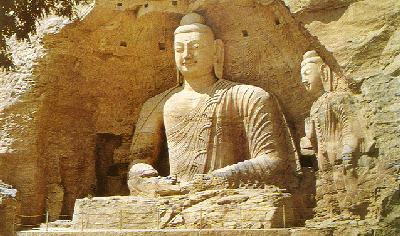 |
From the murals, sculptures and decorations in Qiuzi Grottos of Xinjiang Uygur Autonomous Region and Dunhuang Mogao Grottos in Gansu Province of West China, we can see directly the development of Chinese ancient religious art over ten dynasties. More than 3,000 statues of Buddha remain in Mogao Grottos. The large number, long history and high artistic level of these statues are seldom seen in the world's history of sculpture. The Northern and Southern Dynasties (386-589) was the early period of murals in the Mogao Grottos with designs of Buddha, stories of Buddha, fairy tales, consecrated human figures, decorative patterns, and so on. Most of them were single paintings or group paintings on the same subject. With smooth lines, simple colors and vivid manner, the murals reflected the preliminary combination of foreign Buddhist art and Chinese traditional art. The middle period covers the Sui and Tang Dynasties (581-907). Compared with early works, murals of this period contained less Buddhist stories while horizontal scroll with symmetry composition came into being with trim scope, bright colors and elegant figures. The Later period include the Five Dynasties, Song, Western Xia and Yuan Dynasties (907-1368). Because of the decline of the Silk Road, the activity of cave painting was less, and the artistic level was comparably lower.
Buddhist culture is the product of history. We not only appreciate its high artistic value, but also get rich information on many aspects of ancient Chinese politics, religion, economy and culture.